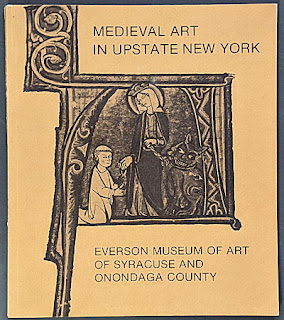It reminded me that, in addition to an Otto Ege portfolio of "Fifty Original Leaves" (digitized here), the Buffalo and Erie County Public Library has some other interesting leaves and codices. I emailed the Library, and Amy J. Pickard, the Rare Book Curator, kindly and very promptly sent me reference images of all the leaves I enquired about.
In addition to a leaf from Ege HL 18 [1] in the "Fifty Original Leaves" portfolio (here), the Library has another leaf from the same manuscript, which we will come to shortly. The 90-leaf carcass of the parent volume was offered (but was apparently unsold) as part of the Ege estate at Sotheby's, 26 November 1985, lot 59 [2], and from this large portion it was possible to attribute the manuscript to "Flanders, possibly Ghent", because the litany includes numerous other Flemish saints, including Livinus and Bavo (who were important in Ghent) highly-placed.
An illuminated leaf from the same Breviary is at Oberlin College Library:
 |
| [Source] |
Another is at the Hatcher Library, Ann Arbor:
And a third is at Columbia University:
 |
| [Source] |
The last of these includes text for a feast of St Landoald (one of the Flemish saints found in the Litany) and his companions:
 |
| "De sancto Landoaldo sociisque eius" |
The loose leaf at the Buffalo and Erie County Public Library does not have an illuminated initial like the three above:
 |
| [This and the following images show a leaf at the Rare Book Collection, Buffalo & Erie County Public Library] |
But a closer look shows that it does have some text that is crucial for identifying the provenance of the parent volume.
The first rubric on the recto introduces a feast of Sts Livinus, Adrian, and Brictius:
 |
| "De sancto Livino Adriano et Brictio" |
 |
"Adesto domine populo tuo ut beatorum martyrum tuorum Livini, Adriani, atque Brictii ..." |
Towards the top of the first column on the verso is a rubric for a feastday 'Of the saints of this place':
 |
| "De sanctis loci istius. ..." |
 |
"... sanctorum confessorum tuorum Lan- doaldi, Macharii, atque A- nantii, et sanctarum vir- ginum Vinciane, Landra- de, Pharahildis, atque ce- terorum qui in presenti requi- escunt ecclesia ..." |
- Landoald: in 980 his relics were transferred, with those of Amantius and Adrian, from Maastricht to St Bavo's Abbey, Ghent [3]. His main feast day was 19 March (the same day as Adrian, see above).
- Macarius: died in 1012 at Ghent and buried at St Bavo's Abbey
- Amantius: a companion of Landoald, see above; relics at St Bavo's Abbey
- Vinciana: sister and missionary helper of Landoald; relics at St Bavo's Abbey
- Landrada: in 980 her relics were transferred, with those of Landoald et al., to St Bavo's Abbey
- Pharahildis: patroness of the city of Ghent; relics at St Bavo's Abbey
Their names are repeated in the next prayer, at the bottom of the first column and top of the second:
 |
"sanctorum confessorum turoum Lan- doaldi, Macharii, atque Amantii et sanctarum virgi-" |
 |
"-num Vinciane, Landra- de, Pharahildis ... [rubric:] De sancto Mar- tino ..." |
The rubric in the second image above shows that the following feast is that of St Martin. Although the prayers appear to be the same as ones used for St Martin of Tours, they are presumbly used here for the less famous St Martin of Braga, whose feast-day was 19 March.
Although some of the individual saints mentioned above had different feast-days (St Bavo's own feast day, for example, was 1 October), it seems that 19 March, the feast-day of St Landoald and Adrian, was used at St Bavo's Abbey for the Feast of the Relics, and that Ege HL 18 was written for use there.
Notes
[1] For an explanation of HL (Handlist) numbers, allocated to Ege MSS by Scott Gwara, see this post.
[2] The description is as follows:
NINETY LEAVES FROM A BREVIARY, IN LATIN, MANUSCRIPT ON VELLUM
[FLANDERS, POSSIBLY GHENT, LATE THIRTEENTH CENTURY90 leaves, still partly stitched, most leaves detached, double column, 26-28 lines, written space c. 104mm. by 80mm., written in black ink in a small gothic hand, rubrics in red, capitals touched in red, versal initials throughout Psalter in red or blue, DECORATED INITIALS THROUGHOUT (usually several to a page) in red or blue with full-length penwork in both colours, a few larger initials divided red and blue with extensive penwork, a few medieval additions, some leaves worn and stained, extremities of some penwork cropped (147mm. by 113mm.)
Leaves from a Breviary which comprised the Ferial Psalter with Litany and the Office of the Dead, the Temporal, Sanctoral and Common. The Litany is present here, and includes many Flemish saints. The first martyr after Stephen is St. Livinus who was martyred at Alost (about half way betwen Ghent and Brussels) and the first confessor is St. Bavo, patron of Ghent. Others include SS. Adrian, Brice, Pancras, Leodegar, Lambert, Landoaldus, Macharius, Amand, Amantius, Donatian, Ausbert, Wulfran, Gudwal, Vedast, Omer, Servatius, Willibrord, Gislenus, Bertin, Bertulf, Landrada, Pharahildis, Elizabeth of Hungary (canonised 1234), etc.
[3] Compare the prayer in a near-contemprary Ghent Cathedral Breviary sold by Les Enluminures: “[...] sanctorum confessorum tuorum Landoaldi, Macharii, atque Amanti et sanctarum virginum tuarum Vintiane, Landrade, Pharahildis atque ceteorum quorum relique in presenti requiescunt ecclesie …”; online here.
[4] Details can be found in Christoph T. Maier, "Saints, Tradition and Monastic Identity: The Ghent Relics, 850-1100", Revue belge de Philologie et d'Histoire, 85.2 (2007), pp. 223-77 [online here], e.g. at p. 242:



No comments:
Post a Comment
** PLEASE INCLUDE YOUR NAME IN YOUR COMMENT **
I may ignore and delete anonymous comments